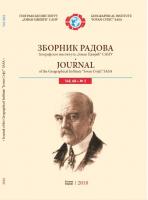SPATIAL-TEMPORAL VARIABILITY OF AIR TEMPERATURES IN
SERBIA IN THE PERIOD 1961–2010
SPATIAL-TEMPORAL VARIABILITY OF AIR TEMPERATURES IN
SERBIA IN THE PERIOD 1961–2010
Author(s): Boško Milovanović, Phillip Schuster, Milan Radovanović, Christopher Schneider, Milovan MilivojevićSubject(s): Geography, Regional studies, Physical Geopgraphy
Published by: Географски институт »Јован Цвијић« САНУ
Keywords: air temperature; trend; Sen’s slope estimation; Mann-Kendall test; Serbia
Summary/Abstract: The aim of this paper is to examine the spatial and temporal variability of the average monthly, seasonal and annual air temperatures in Serbia. Therefore, data from 64 climatologic stations were analyzed in the period from 1961 to 2010. Based on the data, on the position of the stations (their latitude, longitude, altitude), and the characteristics of the terrain in their vicinity (inclination and terrain exposure in a radius of 10 km around the station), a regression model was constructed based on which air temperatures are interpolated for the territory of Serbia. The rootmean- square error (RMSE) of the regression model ranged from 0.2 ºC in January, February and November to 1.1 ºC in August. Spatial distribution of air temperatures is shown (maps of mean monthly, mean seasonal and mean annual air temperatures are made), and the Sen's procedure was used to calculate trends of air temperatures (maps of average monthly, mean seasonal and mean annual trends of air temperatures). The Mann-Kendall test was used to test the significance of air temperature trends. Apart from the southeast, the whole territory of Serbia has practically experienced a statistically significant rise in the average annual air temperature, with the highest increase in the summer and winter months.
Journal: Зборник радова Географског института "Јован Цвијић" САНУ
- Issue Year: 68/2018
- Issue No: 2
- Page Range: 157-175
- Page Count: 19
- Language: English, Serbian

